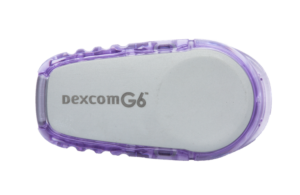
As an early adopter of fitness trackers such as the FitBit, I’ve long appreciated the power of health data. But my recent experience with a continuous glucose monitor (CGM) has done far more to inspire me to look after my health — even as a nondiabetic.
I had heard about the potential of such technology before from the cardiologist Dr. Eric Topol, who serves on the board of Dexcom (NASDAQ:DXCM), and the entrepreneur Tim Ferriss, who has discussed using the technology as a non-diabetic to optimize weight loss and muscle gain.
But I have only recently had the chance to evaluate CGM as part of Dexcom’s “Hello Dexcom” sample program that enables patients to try out the company’s G6 CGM at no cost. The goal of the program is to increase awareness among healthcare providers and consumers.
The G6 device, pictured above, provides blood glucose readings every 5 minutes for 10 days via a smartphone app or dedicated receiver.

Modern CGM technology enables users to see within minutes the impact of diet and exercise on their bodies. Within 30 minutes of eating something sweet, for example, I watched my blood sugar spike. Even though my blood glucose levels were generally stable and normal, the experience of seeing blood sugar spikes has inspired me to scale back on refined carbohydrates.
Another intriguing aspect of using a CGM is getting tangible data on how specific foods affect your body. Certain foods — like brown rice, oatmeal and bananas — caused my numbers to increase more than expected. Others, like 100% whole grain bread, led to more modest gains.
Tea and coffee also seemed to cause slight increases.
In some people with diabetes, even black coffee can cause large blood sugar spikes.
The impact of exercise on blood glucose was also pronounced.
Going for a walk up a steep hill after a meal seemed to cause a significant blood sugar decrease. Conversely, jogging would cause a temporary blood sugar spike, while being sedentary for a couple of hours would cause a modest rise.
It’s easy to see the benefits of the technology for people with diabetes — and even prediabetes.
My CGM experience also raised questions about the out-of-pocket costs for some patients. A month’s supply of CGM sensors can cost a few hundred dollars, depending on the model and brand. While some patients have CGM expenses subsidized by insurance companies or Medicare, current eligibility requirements for coverage tend to be restrictive.
Then, there is the question of sustainability. While Dexcom has been exploring a recycling program for the one-button plastic sensor applicator, which is roughly the size of a computer mouse, the device’s blood-contacting components complicate that goal.
Also, given my experience installing a range of connected devices, including smart speakers and home automation technology, I found the CGM app occasionally frustrating.
But the potential to dig into blood sugar data and analyze data trends was motivating in a way that I have not found from other connected health devices, whether connected scales, fitness trackers, blood pressure cuffs or smartphone-based ECGs.
Dexcom recently found in market research that 75% of people with diabetes are unfamiliar with CGM technology’s potential.
Given that the technology has inspired me to establish a long-term diet and exercise goals as a nondiabetic, I can see how CGMs can be especially powerful for people with diabetes.